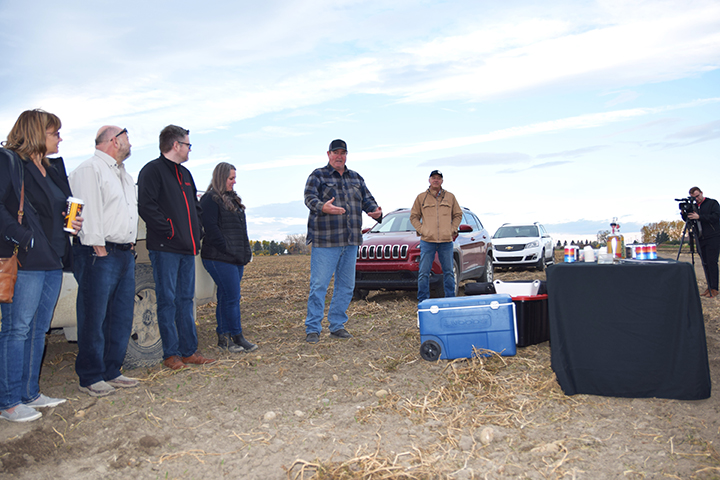Current Temperature
5.9°C
Harvest tour digs into sugar beet farming
Posted on October 24, 2024 by admin Times Photo by Cal Braid. TOUR: The Alberta Sugar Beet Growers harvest tour on Oct. 16 took a group to the farm of Gary Tokariuk (lower centre plaid jacket), where he grew 152 acres of sugar beets in 2024. His beet harvest was about 75 per cent completed.
Times Photo by Cal Braid. TOUR: The Alberta Sugar Beet Growers harvest tour on Oct. 16 took a group to the farm of Gary Tokariuk (lower centre plaid jacket), where he grew 152 acres of sugar beets in 2024. His beet harvest was about 75 per cent completed.By Cal Braid
Vauxhall Advance
Local Journalism Initiative Reporter
On Oct. 16, the Alberta Sugar Beet Growers held their annual harvest tour, and it was a great learning experience for anyone interested in southern Alberta’s agriculture industry. The ASBG is the marketing board that administers quotas for crop growth and negotiates pricing contracts with the processor, Lantic Inc. Its growers collectively farm a 28,000 acre quota of sugar beets in an average year, based on the factory’s capacity to store and process the beets.
Registrants showed up at the Taber Community Centre before 8 a.m. to mingle before heading out on the buses to the farmer’s field. ASBG executive director Jennifer Crowson and communications coordinator Siobhan Gardner handed out homemade breakfast sandwiches and croissants beforehand, and the buses were well stocked with Tim’s coffee to start the day off right. The tour group included attendees from agriculture, sales, finance, the municipality, and the county, among others.
“So we need to increase the productivity in our economy, and then people have more money in their pocket,” he continued. “Then on the other side, you don’t add on taxes and increase government spending. What you spend as a government is what you receive. So if you want to do something different, find something that maybe you don’t need to do, and get the money from that to make it work.”
“People do it. People know how to balance the budget. When they run out of money, they can’t spend anymore. And that’s the view of what the government’s got to do.”
He singled out immigration as another area of focus. “It’s one that I hear about a lot, with people saying, ‘Why are we having all these people come to Canada? We get problems in Canada with housing and something’s wrong, but yet I can’t get a family doctor.’”
Having recently met with deans of agricultural schools, he talked about how they are developing a program for foreign veterinarians who have come to Canada. “They’re ahead of the doctors doing this, of medical doctors. They’ve set up programs to train and educate and get licensed veterinarians who are in Canada from other countries. So when people are saying, ‘I need a vet, and it’s costing me a lot of money,’ there are none available. They’re absolutely right. So the deans of the agriculture school or their vet schools took on a way to find those people in Canada and entice them into programs so they could be veterinarians here.”
“When we talk about what we need for immigration, we identify what we need in our country, and those are the types of immigration policies we should have, not having a million universities,” he said.
He thought that giving a Visa to undergrad students to draw them into Canadian post-secondary schools created housing problems. It creates difficulty for those people as they come as students who then expect that they will be citizens. “Mass immigration like that doesn’t match up with what is needed in our country,” he said.
In an agricultural area, he thinks having temporary foreign workers who stay seasonally or longer through work programs is beneficial. “We have examples where the programs do work. So immigration should match what we need in our economy. If it’s doctors, it’s doctors, if it’s truck drivers, how do we educate the people here first? And I think part of it is we need to identify the programs and entice people who live here to get trained in those programs first.”
Shields said a Conservative plan would address specific shortages and use immigration to fill in those gaps. “Let’s have training for those people who are here in Canada first, and then look at immigration where the gaps are. That’s what we would do.”
Leave a Reply
You must be logged in to post a comment.

